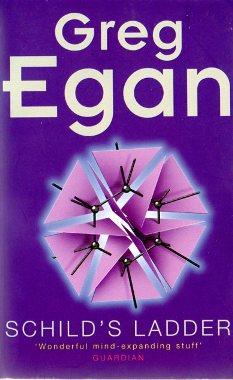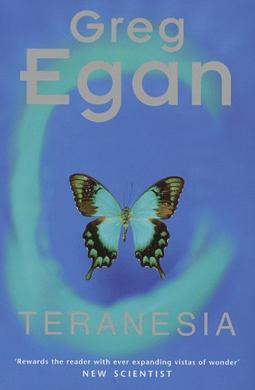Related Research Articles
Greg Egan is an Australian science fiction writer and mathematician, best known for his works of hard science fiction. Egan has won multiple awards including the John W. Campbell Memorial Award, the Hugo Award, and the Locus Award.

Schild's Ladder is a 2002 science fiction novel by Australian author Greg Egan. The book derives its name from Schild's ladder, a construction in differential geometry, devised by the mathematician and physicist Alfred Schild.

Teranesia is a 1999 science fiction novel by Greg Egan. The novel follows protagonist Prabir Suresh, who lives on an island in the South Moluccas with his biologist parents, who are investigating the unique evolutionary traits of butterflies on the island. As civil war erupts in Indonesia, Prabir and his baby sister Madhusree must escape the islands. When they grow up, Madhusree becomes a biology student, motivated to carry on her parents' legacy in uncovering the evolutionary phenomenon. Prabir reluctantly follows her, as he must navigate and confront the truth that shaped his past.

Jennifer Egan is an American novelist and short-story writer. Her novel A Visit from the Goon Squad won the 2011 Pulitzer Prize for Fiction and National Book Critics Circle Award for fiction. From 2018 to 2020, she served as the president of PEN America.
The Clockwork Rocket is a hard science-fiction novel by Australian author Greg Egan and the first part of the Orthogonal trilogy. The novel was published by Night Shade Books on 1 July 2011 with a cover art by Cody Tilson and by Gollancz on 15 September 2011 with a cover art by Greg Egan. The novel describes an alien civilization being threatened by the appearance of hurtling meteors entering their planetary system with an unprecedented speed and the implementation of an unusual plan: All the technology needed for an effective defense shall be developed on board of a generation ship launched into the void while only a few years pass back on the home world in the meantime due to time dilation. This is possible due to different laws for space and time in this universe, in which they have the same signature instead of different ones, or which is alternatively described by a Riemannian instead of a Lorentzian manifold. The consequences on some of the physical concepts needed in the novel including time dilation and radiation, are described by Greg Egan with diagrams in the novel and also his website. The story is continued in The Eternal Flame and The Arrows of Time.
"The Moral Virologist" is a science fiction short story by Greg Egan. It was first published in September 1990 in Pulphouse Magazine, and subsequently republished in 1991's The Best of Pulphouse, in the Summer 1993 issue of Eidolon magazine, and in Egan's 1995 collection Axiomatic. An Italian-language version, "Il Virologo Morale", was published in 2003.
"The Hundred Light-Year Diary" is a science-fiction short story by Australian writer Greg Egan, first published in Interzone 55 in January 1992. It was later published in the short story collection Axiomatic. It was a finalist for the 2007 Premio Ignotus for Best Foreign Story.
The Eternal Flame is a hard science-fiction novel by Australian author Greg Egan and the second part of the Orthogonal trilogy. The novel was published by Night Shade Books on 26 August 2012 with a cover art by Cody Tilson and by Gollancz on 8 August 2013 with a cover art by Greg Egan. The novel describes the journey of the generation ship Peerless, which has departed in The Clockwork Rocket, and the development of new technology as well as changes of the society on board. An essential task is the construction of an engine not needing any fuel to generate thrust, but instead perfectly balancing out the radiation it emits with the energy this generates. To make such a process work, the universe of the novel is based on a Riemannian instead of a Lorentzian manifold, changing the rules of physics. The details are described by Greg Egan on his website. The story is continued in The Arrows of Time.
The Arrows of Time is a hard science-fiction novel by Australian author Greg Egan and the third part of the Orthogonal trilogy. The novel was published by Gollancz on 21 November 2013 with a cover art by Greg Egan and by Night Shade Books on 5 August 2014 with a cover art by Cody Tilson. The novel describes the return journey of the generation ship Peerless, which has been launched in The Clockwork Rocket and traveled into the void in The Eternal Flame, and the reverse enabling the construction of a device to receive messages from the own future as well as the journey to a world where time runs in reverse. The universe of the novel is therefore based on a Riemannian instead of a Lorentzian manifold, changing the rules of physics. The details are described by Greg Egan on his website.
"Axiomatic" is a science-fiction short story by Australian writer Greg Egan, first published in Interzone 41 in November 1990. The short story was included in the collection The Best of Greg Egan in 2020.
Dark Integers and Other Stories is a collection of five science-fiction short stories by Australian writer Greg Egan, published in 2008 by Subterranean Press. One of them, "Oceanic", won the Hugo Award for Best Novella, while two others were nominated.
Crystal Nights and Other Stories is a collection of nine science-fiction short stories by Australian writer Greg Egan, published on 30 September 2009 by Subterranean Press. Two of the stories were nominated for the Hugo Award.
Oceanic is a collection of 12 science fiction short stories by Australian writer Greg Egan, published on 16 July 2009 by Gollancz.
"Luminous" is a science-fiction short story by Australian writer Greg Egan, first published in Asimov’s Science Fiction in September 1995.
"Dark Integers" is a science-fiction short story by Australian writer Greg Egan, first published in Asimov's Science Fiction in October/November 2007. The short story was included in the collections Dark Integers and Other Stories in 2008, Oceanic in 2009 and The Best of Greg Egan in 2020. It was nominated for the Hugo Award for Best Novelette in 2008. It is a sequel to the short story "Luminous".
"The Cutie" is a science-fiction short story by Australian writer Greg Egan, first published in Interzone #29 in May/June 1989. It was his first to be published in Interzone. The short story was included in the collection Axiomatic in 1995. It also appeared in the anthology Interzone: The 4th Anthology edited by John Clute, David Pringle and Simon Ounsley in 1989.
"Appropriate Love" is a science-fiction short story by Australian writer Greg Egan, first published in Interzone #50 in August 1991. The short story was included in the collection Axiomatic in 1995 and The Best of Greg Egan in 2019.
"Induction" is a science-fiction short story by Australian writer Greg Egan, first published in Foundation 100 edited by Farah Mendlesohn and Graham Sleight in 2007. The short story was included in the collections Crystal Nights and Other Stories and Oceanic in 2009. It also appeared in the anthology Year's Best SF 13 edited by David G. Hartwell and Kathryn Cramer in 2008.
"Transition Dreams" is a science-fiction short story by Australian writer Greg Egan, first published in Interzone #76 in October 1993. The short story was included in the collections Our Lady of Chernobyl in 1995 and Luminous in 1998. The short story is set in the same universe as Egan's novel Diaspora.
"Learning to Be Me" is a science-fiction short story by Australian writer Greg Egan, first published in Interzone 37 in July of 1990. The short story was included in the collections Axiomatic in 1995 and The Best of Greg Egan in 2019.
References
- ↑ Greg Egan at the Internet Speculative Fiction Database
- ↑ Singleton title listing at the Internet Speculative Fiction Database
- ↑ "Bibliography". Greg Egan. April 9, 2024. Retrieved April 17, 2024.
- ↑ "Singleton". Greg Egan. August 8, 2002. Retrieved April 19, 2024.
- ↑ Karen Burnham (April 13, 2014). "Free Will in a Closed Universe: Greg Egan's Orthogonal Trilogy". New York Review of Science Fiction . Retrieved May 4, 2016.
- ↑ "Greg Egan Awards Summary". October 15, 2023. Retrieved April 9, 2024.